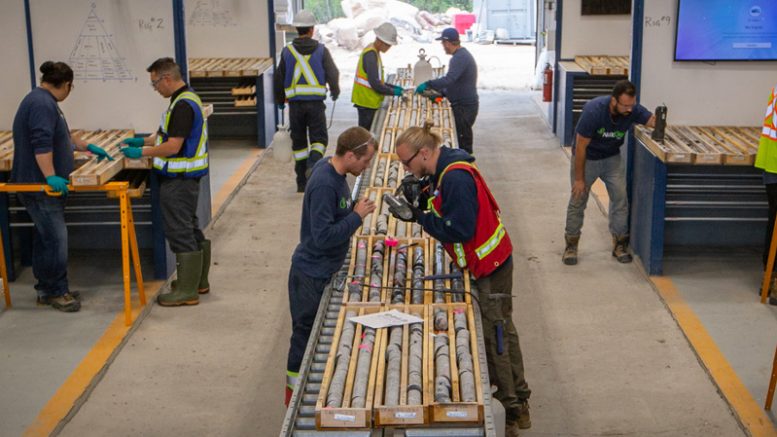NexGen Energy (TSX: NXE; NYSE: NXE; ASX: NXG) has reported high-grade uranium assays east of its main Arrow deposit in northern Saskatchewan that are stronger than the first Arrow discovery hole a decade ago.
The Patterson Corridor East (PCE) discovery hole RK-24-183 cut 13.5 metres grading 0.78% uranium oxide (U3O8) from 347.5 metres depth, including 0.5 metres at 10% U3O8 and another 0.5 metre at 6.23% U3O8, NexGen said in a release Wednesday. That compares with the 5.7 metres at 0.37% U3O8, including 0.2 metres at 5.77% U3O8 result from the RK-14-21 discovery hole in 2014 at Arrow, considered the largest development stage uranium deposit in Canada.
Hole RK-24-193, 275 metres southwest along strike of RK-24-183 returned mineralization over 67.5 metres from 383.5 metres depth, including intervals up to 7,500 counts per second (cps) over 1.5 metres, according to gamma spectrometer readings.
“Our team has assessed the geological similarities between RK-24-183 and RK-24-193 and the upper areas of Arrow, which indicates the high prospectivity of an additional mineralized system 3.5 km east of Arrow,” CEO Leigh Curyer said. “The growing potential of this latest discovery will drive the focus of the summer exploration program to determine the potential size and extent of mineralization. Efficient and bold testing of the overall system is the first priority.”
Nuclear metal security
The results at PCE come a day after NexGen announced the closure of its 2.7 million lb. purchase of U3O8 from Cayman Island fund manager MMCap International for US$250 million in unsecured convertible debentures. The debentures will be convertible to about 23 million common shares of NexGen, equal to about 4.3% of the company’s issued and outstanding common shares.
The transaction was designed to maximize the value of NexGen’s uranium inventory as it looks ahead to production and sales, Curyer said in a release.
“Further, having access to 2.7 million pounds of uranium at surface in inventory will no doubt prove to be increasingly strategic given the recent passing of the Prohibiting Russian Uranium Imports Act into U.S. law,” he added.
At PCE, the mineralization and alteration density in hole RK-24-193 strongly resembles the up-dip projection that was detected in the early discovery holes at Arrow, NexGen said.
Summer exploration at PCE is to include more than 22,000 metres of diamond drilling, using four rigs. That capacity almost triples the drilling from the winter to summer programs, NexGen said. Targets will mainly be tested between 400 and 700 metres below surface to test potential depth extensions.
The drill results and uranium buy add to the tailwinds the Vancouver-based company has experienced over the past several months, after it secured provincial environmental approval (EA) last November for its Rook I mine at Arrow, in the southwestern Athabasca Basin. NexGen is awaiting responses from the federal government on its EA for Rook.
NexGen released a feasibility study for Rook I in 2021 that outlined an 11-year operation that would produce 21.7 million lb. of uranium oxide annually and cost US$1.3 billion to build.
Arrow hosts measured and indicated resources of 3.8 million tonnes grading 3.1% U3O8 containing 256.7 million lb. U3O8, and 4.4 million inferred tonnes at 0.83% U3O8 containing 80.7 million lb. U3O8.
Nexgen shares were down 2.8% to $10.54 apiece on Wednesday morning as the wider market fell, valuing the company at $5.7 billion. Its shares traded in a 52-week range of $4.91 and $12.14.


Be the first to comment on "NexGen scores higher grade uranium find than at flagship’s discovery hole in Saskatchewan"